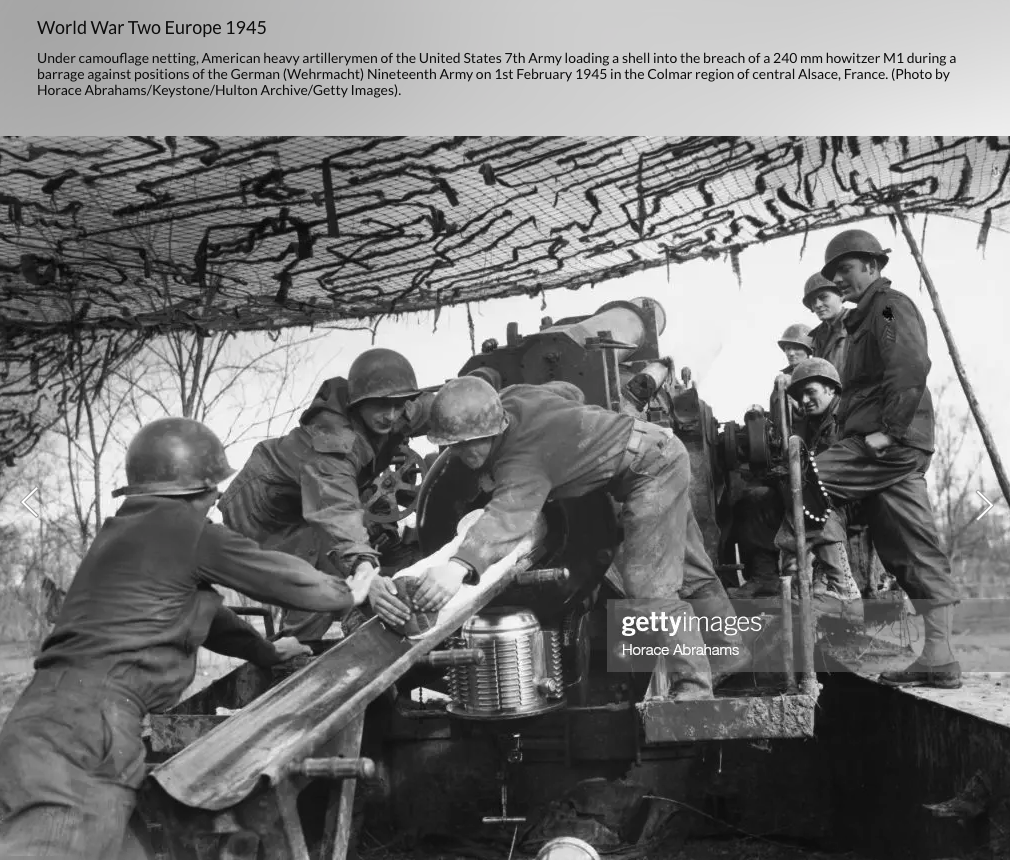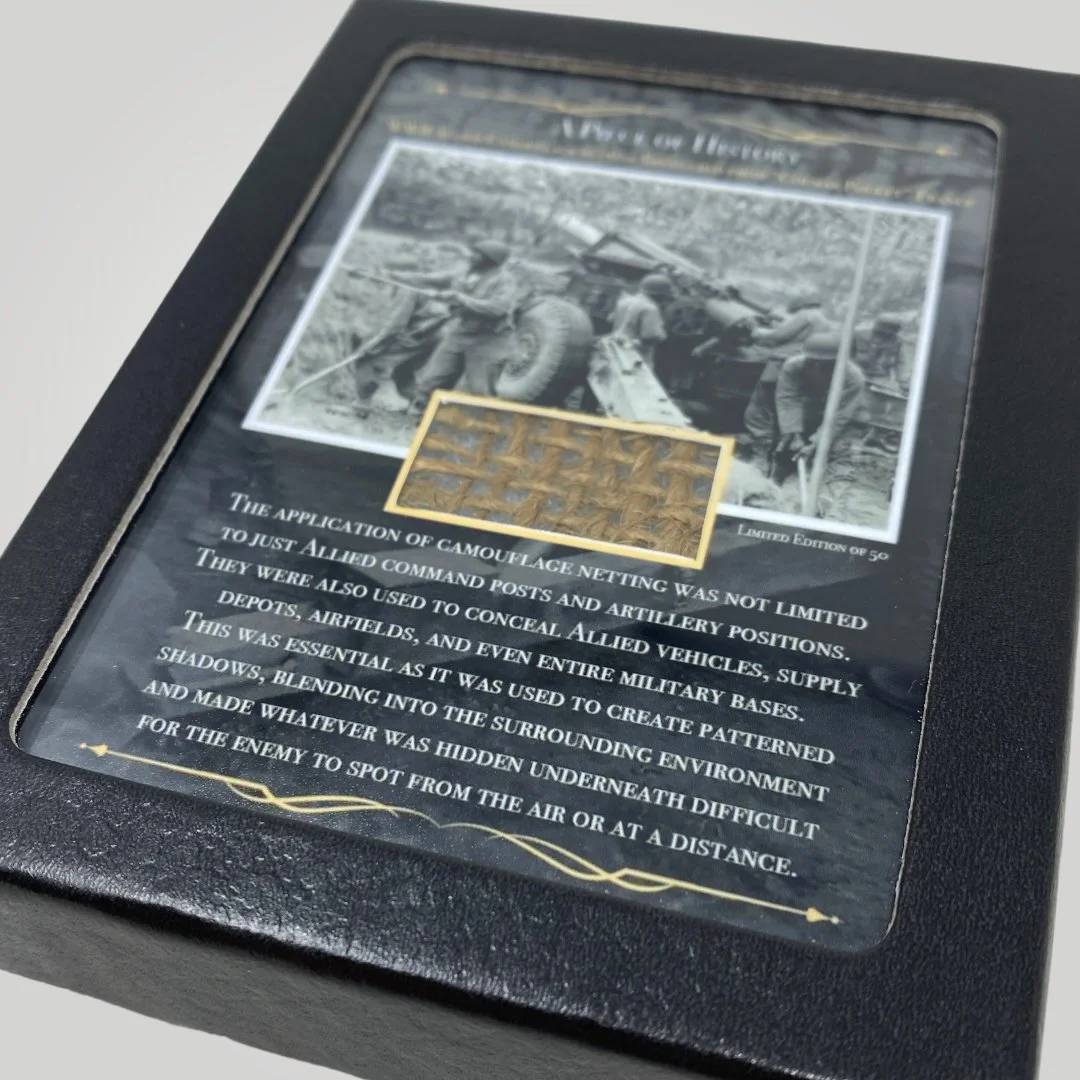RARE! WWII U.S. Army Camouflage Artillery Netting Recovered From “Colmar Pocket” France Battlefield with Display Case (C.O.A. Included)



































RARE! WWII U.S. Army Camouflage Artillery Netting Recovered From “Colmar Pocket” France Battlefield with Display Case (C.O.A. Included)
Comes with a hand-signed C.O.A. and a full historical research write-up.
*Limited Edition of 50*
Own your piece of history today!
Due to an incredibly high demand for display case options we are proud to offer one of our LIMITED EDITION series of HISTORIC DISPLAY CASE EXCLUSIVES. This incredible “Piece of History“ is professionally encased in a glass display case with plush padding and a tightly sealed display case. Each displays features a historical photograph and short description that corresponds to the artifact displayed. This display case measures a perfect 4.25 inches tall x 3.25 inches wide.
This series is a limited edition of 50 pieces, meaning that each “Piece of History” display is unique. The artifact you receive may vary slightly from the display shown.
This rare and very historic piece of WWII history is an original piece of WWII U.S. Army camouflage netting recovered from the “Colmar Pocket” battlefield. As the German offensive in the Ardennes ended in defeat for the crumbling Third Reich, another fierce battle raged to the south over a similar feature roughly centred on the city of Colmar. This block of territory that became known as the Colmar Pocket, consisting of 850 square miles on the west side of the Rhine River, was the Germans’ last piece of France territory. Three whole months would pass between the liberation of Strasburg and the one of Colmar, with desperate German resistance holding up the Allied advance before finally collapsing. Fighting in the Colmar pocket would continue until 9 February. The battle itself had lasted twenty-one days in freezing conditions and resulted in heavy Allied losses, with 8,000 American dead and 16,000 French. The 19th German Army, under General Raspe, lost over 20,000 men, with a further 16,000 been taken prisoners.
The Colmar Pocket was the area held in central Alsace, France, by the German Nineteenth Army from November 1944 to February 1945, against the U.S. 6th Army Group (6th AG) during World War II. It was formed when 6th AG liberated southern and northern Alsace and adjacent eastern Lorraine, but could not clear central Alsace. During Operation Nordwind in December 1944, the 19th Army attacked north out of the Pocket in support of other German forces attacking south from the Saar into northern Alsace. In late January and early February 1945, the French First Army (reinforced by the U.S. XXI Corps) cleared the Pocket of German forces.
A German bridgehead on the west bank of the Rhine 65 kilometres (40 mi) long and 50 kilometres (30 mi) deep was isolated in November 1944 when the German defenses in the Vosges Mountains collapsed under the pressure of an offensive by the U.S. 6th Army Group. General Jean de Lattre de Tassigny's French First Army forced the Belfort Gap and destroyed the German IV Luftwaffe Field Corps near the town of Burnhaupt in the southern Vosges Mountains. Soon afterwards, French forces reached the Rhine in the region north of the Swiss border between Mulhouse and Basel. Likewise, in the northern Vosges Mountains, the French 2nd Armored Division spearheaded a U.S. Seventh Army advance, forced the Saverne Gap, and drove to the Rhine, liberating Strasbourg on 23 November 1944. The effect of these two advances was to collapse the German presence in southern Alsace west of the Rhine to a semi-circular bridgehead centered on the town of Colmar that came to be known as the "Colmar Pocket".
Apart from Normandy, the areas of France most bitterly defended by the Germans were Alsace and Lorraine. This occurred in part because the Allied surge across France in 1944 was slowed down by logistical difficulties as the Allies reached the easternmost extent of France, but the primary reason for the stout German defenses of these regions is that Alsace and Lorraine were claimed as part of Germany and would be defended as strongly as any other German soil. This perception informed Hitler's decisions of 24 November and 27 November 1944, that committed General Siegfried Rasp's 19th Army to a do-or-die defense of the region around Colmar. On 26 November, the Germans formed Army Group Oberrhein under the command of Heinrich Himmler and tasked his command with the defense of the front between the Bienwald and the Swiss border. Of prime importance to the German defense around Colmar were the bridges over the Rhine at Breisach and Chalampé, since it was over these bridges that supplies were delivered.
On New Year's Day 1945, the Germans launched Unternehmen Nordwind (Operation "North Wind"), one objective of which was the recapture of Strasbourg] German troops of the 198th Infantry Division and the 106th Panzer Brigade attacked north out of the Colmar Pocket from 7–13 January. Although the defending French II Corps suffered some minor losses during this attack, the French held the front south of Strasbourg and frustrated German attempts to recapture the city. Following the failure of Nordwind, 6th Army Group was ordered to collapse the Colmar Pocket as part of General Dwight D. Eisenhower's plan for all Allied forces to close on the Rhine prior to invading Germany. Since the bulk of Allied troops surrounding the Colmar Pocket were French, this mission was assigned to the French First Army.
The U.S. 3rd Infantry Division had moved into the Vosges Mountains during mid-December to replace the worn-out U.S. 36th Infantry Division and so was already in place to support the reduction of the Colmar Pocket. Realizing the French would need the assistance of additional U.S. troops for the coming battle, General Jacob Devers, commander of 6th Army Group, arranged for the transfer of a U.S. division from another part of the front. The U.S. 28th Infantry Division duly arrived from the Ardennes front and took up position along the right flank of the U.S. 3rd Infantry Division. With the 28th Division in the Kaysersberg Valley, the 3rd Division would be able to concentrate for an attack against two German divisions, the 708th (a Volksgrenadier division) and the 189th Infantry. Additionally, a U.S. armored division, the 10th, was scheduled to support the offensive, but as events developed, it was the U.S. 12th Armored Division that was eventually committed to the battle.